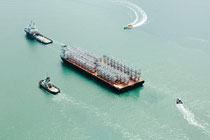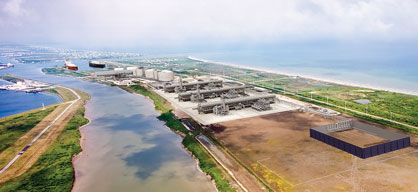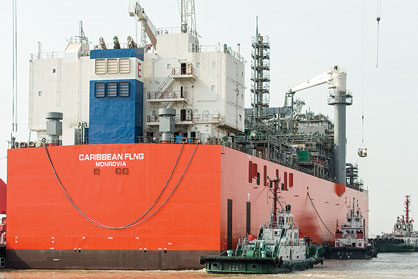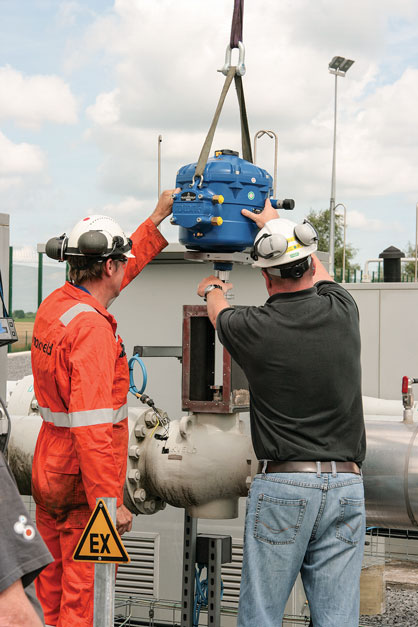Gas processing news
H. Meche, Associate Editor
Modules complete for Curtis Island LNG projects

Bechtel has announced that all 260 modules comprising the three LNG plants the company is building on Curtis Island in Queensland, Australia, are now onsite. The final module has been delivered to the Australia Pacific LNG project. The modules (prefabricated steel structures that house the production units) were built by Bechtel in Indonesia, Thailand and the Philippines, and then shipped to Australia.
The modules for the Queensland Curtis LNG, Gladstone LNG and Australia Pacific LNG projects were designed, built and delivered over a three-year period. The Gladstone LNG project consists of 111 modules, the Queensland Curtis LNG terminal has 80 modules and the Australia Pacific LNG project has 69 modules. The tallest module measures more than 100 ft, and the longest is more than 250 ft. The combined weight of the steel structures equals that of 12 Eiffel Towers.
Mongolian LNG project sees progress
Air Products will supply its proprietary LNG process technology and equipment to Technip for a mid-scale LNG project in Fengzhen City, Inner Mongolia, China. Air Products’ technology will be key to a liquefaction train producing approximately 300 Mtpy of LNG for Fengzhen Wanjie Gas Co. Ltd. The LNG facility is targeted to be onstream by the second half of 2016.
Under the agreement, Air Products will supply its single mixed-refrigerant process technology, as well as the engineering, design and manufacturing of the heat exchanger equipment for the liquefaction section. The liquefaction process at this site will use Air Products’ proprietary coil-wound main cryogenic heat exchanger technology.
Pipeline refurbishment program delivers major gains

A major gas transmission operator in the mountains of eastern Poland, along the
Ukraine border, commissioned T.D. Williamson (TDW) to clean and inspect a 28-in.-diameter,
6.8-mi section of a 24.8-mi pipeline that was commissioned in the early 1970s.
The line, which was operating at a pressure of 38 barg, at an average flow of 75,000 m3/hr, was so choked by debris that a pipeline cleaning or an inspection pig was unable to pass. In addition, a TDW visibility study, prior to cleaning and inspection, revealed a section of the line with eight acute miter bends, making it impossible for pigs to navigate and clean, let alone inspect.
Working in cooperation with the operator, TDW developed a solution to address the problem. Custom-designed temporary pig launchers and receivers were built and welded at strategic points along the line. The miter bends were removed and replaced with pipe that would accommodate the cleaning and inspection pigs. All pigs were fitted with transmitter units that allowed the crew to track their progress.
Finally, to verify the line’s piggability and ensure that its cleaning pigs and inspection tools would be able to negotiate the pipeline, TDW performed a gauge pig run. Once this was completed, preparations were made to proceed with cleaning runs.
To clean the lines, a five-step cleaning program was carried out by TDW with 24 cleaning pigs. After completing the runs, the 6.8-mi line was clean and free of debris, allowing gas to flow more freely.
Freeport LNG begins work on trains

Freeport LNG Expansion LP’s subsidiaries, FLNG Liquefaction LLC and FLNG Liquefaction 2 LLC, have closed on debt and equity financing commitments of approximately $11 B in capital required for the development of the initial two trains of Freeport LNG’s natural gas liquefaction and LNG loading facility on Quintana Island near Freeport, Texas. Commitments in excess of the anticipated $9.64 B in project costs, inclusive of financing costs, provide a buffer for contingencies and cost overruns to ensure successful completion.
With closing on financing, Freeport LNG has completed all milestones and issued a full notice to CB&I Inc. and Zachry Industrial Inc. to begin construction of the first two liquefaction trains of the Freeport LNG project. Financing and commencement of construction on the third train
is expected in the second quarter of 2015. The first train is expected to start operations in the third quarter of 2018, with the second train slated to commence operations five months later.
Freeport LNG awarded contracts to a JV of CB&I Inc. and Zachry Industrial Inc. to construct the initial two trains of the liquefaction project. The first two trains are anticipated to commence operations 45 months and 50 months from the start of construction, respectively, with the third train expected to be in operation approximately six months following the second train. Each liquefaction train has a nameplate design capacity of 4.64 MMtpy. Photo courtesy of Freeport LNG Development LP.
Chinese SNG plant transforms coal into clean energy
Haldor Topsøe AS designed the methanation section of the Huineng SNG plant, which is now onstream near the city of Ordos, Inner Mongolia, China. The plant is owned and operated by private Chinese company Huineng Coal Electricity Group, and it represents an investment of
$1.1 B. It will produce approximately 400 MMcmy of synthetic natural gas (SNG) based on coal gasification.
The SNG produced at Huineng will be liquefied into LNG, and the facility expects to produce a total of 280 Mtpy. The LNG will be transported to gas stations in Ordos and the surrounding area.
The Huineng plant uses Haldor Topsøe’s TREMP methanation technology to efficiently and cost-effectively produce SNG. As part of the Huineng methanation unit, Haldor Topsøe designed a hot steam superheater, which produces steam at a temperature of 530°C. This steam is used to generate electricity, improving the energy efficiency of the entire complex.
Third gas plant for Musreau facility
Pembina Pipeline Corp. plans to construct a new facility and expand gas processing capacity at its Musreau plant in Alberta, Canada by 100 MMcfd for an estimated cost of $105 MM.
The new facility, known as Musreau 3, is underpinned by long-term agreements with several area producers and involves the construction of a 100-MMcfd shallow-cut facility to be built adjacent to Pembina’s existing Musreau facility and its nearly complete Musreau 2 facility.
Pembina expects Musreau 3 to have liquids extraction capacity of approximately 3 Mbpd, subject to gas compositions. Similar to the company’s other gas processing facilities, the agreements for Musreau 3 are take-or-pay in nature and provide flowthrough of operating expenses. Subject to regulatory and environmental approval, Pembina anticipates bringing Musreau 3 onstream in mid-2016.
Undocking the first FLNG vessel

A ceremony was held to celebrate the undocking of the Caribbean FLNG facility from the Wison Offshore & Marine dry dock in Nantong, China, bringing the project one step closer to commercial realization. The Caribbean FLNG project, which is in the race to be the world’s first operational FLNG facility, was delivered by Wison at its yard in Nantong under an engineering, procurement, construction, installation and commissioning contract with EXMAR. The unit comprises a non-propelled barge that will be operated off the Caribbean coast of Colombia for Pacific Rubiales Energy and equipped to convert approximately 72 MMscfd of natural gas into LNG for temporary storage and export.
Black & Veatch is responsible for the engineering and procurement of the topsides equipment, as well as for providing the patented PRICO LNG liquefaction technology. Wison and Black & Veatch are now completing the commissioning activities on the facility in preparation for sail away and delivery to its location in Colombia by the end of the second quarter of 2015.
With the Caribbean FLNG unit out of its Nantong dry dock, Wison is now using the area for fabrication of its second LNG facility, a barge-based floating regasification unit for a 50/50 JV between EXMAR and Pacific Midstream Holding Corp., a fully owned affiliate of Pacific Rubiales Energy.
Emergency response systems under development
Gas Technology Institute (GTI) has been awarded a project by the US Department of Homeland Security to develop a Gas Situational Awareness System (GSAS). This system is for major events requiring response by more than one emergency responder, utility or agency.
Serving as a data exchange methodology for critical natural gas infrastructure operators and government agencies, it will ensure a coordinated response and enable the sharing of information, thereby providing situational awareness, assisting with decision support during disasters and hastening recovery.
The Gas Outage Management System (GOMS) will allow utilities to identify high-risk pipe segments so that mitigation and restoration resources can be deployed to the most critical assets. It will provide details on how to manage the individual utility response to the outage, including details specific to that particular utility’s control devices, valves and related infrastructure. It will link with the utility’s internal infrastructure mapping system, customer database and work-order system to coordinate internal resources.
The parallel GSAS and GOMS systems will each have information that is useful to the other system, yet each will be independent and will not require the other system to operate.
Launch of plant data exchange
The Gas Plant Data Exchange (GPEX), a collaboration between Oildex and Quorum Business Solutions Inc., distributes data from gas processing facility operators to natural gas producers. The GPEX technology platform serves as a secure, online exchange where processors and producers can share gas plant statements more efficiently.
Processors will publish gas plant statements to GPEX, and producers will subscribe to access only their relevant gas plant statement data. The platform streamlines this process, offering the benefits of reduced turnaround time, improved accuracy, minimal manual intervention, fewer prior period adjustments and increased data visibility.
Blending process adopts valve technology

Rotork’s CVA electric control valve actuator technology has improved performance and reduced operating costs for a European natural gas distribution network’s gas blending process.
Fluxys, the independent operator of the natural gas storage and transmission system in Belgium, wished to improve the blending process, and identified valve actuation as a key area. Prodim, Rotork’s agent in Belgium, proposed the use of the CVL-5000 electric control valve actuator as an alternative to the existing actuator on a blending flow control valve in a trial at the Fluxys booster station at Le Roeuix, Belgium. As well as simplified, all-electric operation with low-power consumption, the CVL-5000 delivers a high-thrust linear output performance that suits the heavy-duty demands of the large control valves used in the application, combined with a programmable integral failsafe capability.
Engineers from Fluxys, Rotork and Mokveld removed the existing actuator; fitted an ATEX-certified explosion-proof CVL-5000 actuator; reconnected the control signal; and carried out a series of tests that demonstrated improved response times, accurate valve positioning, low running costs and fail-to-position operation on loss of main supply. As a result of this change, Fluxys has decided to adopt the CVL-5000 as the standard actuator for its gas blending plants.
LNG facility commissioned in Canada
Ferus Natural Gas Fuels Inc. (Ferus NGF) has opened the first merchant LNG facility in Canada. The facility, which became commercially operational in May, is located in Elmworth, Alberta, Canada, about 65 km southwest of Grand Prairie.
Ferus NGF’s Elmworth LNG plant is strategically located in the heart of oil and gas activity in northwest Alberta and northeast British Columbia. It produces LNG fuel for engines used in drilling rigs and other equipment. To support the entire LNG supply chain, Ferus NGF has also designed and built specialized mobile storage and dispensing equipment to provide full-service fueling solutions.
Ferus sources lean gas from Conocophillips that the company then heat-exchanges with its own liquid nitrogen. The facility can produce up to 50 Mgpd of LNG and has the capacity to expand to 250 Mgpd of LNG.
ONEOK acquires NGL assets
ONEOK Partners LP has acquired NGL pipelines and related assets from affiliates of Chevron Corp. for approximately $800 MM.
ONEOK now owns an 80% interest in the West Texas LPG Pipeline Ltd. Partnership and 100% of the Mesquite Pipeline, which collectively consists of approximately 2,600 mi of NGL gathering pipelines extending from the Permian Basin in southeastern New Mexico to East Texas and Mont Belvieu, Texas. GP




Comments